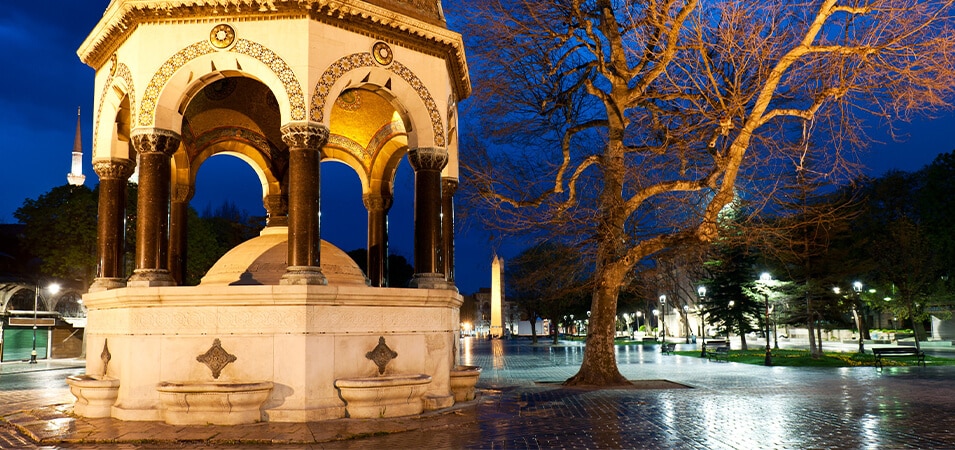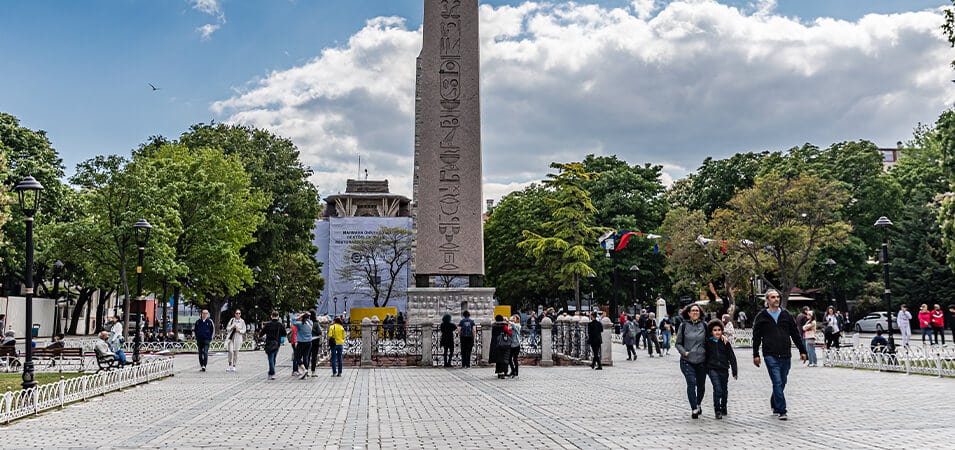The Hippodrome of Constantinople, also known as the Atmeydan (“Horse Square”) in Turkish, was an ancient chariot racing arena in Istanbul, Turkey. Built during the reign of the Roman emperor Septimius Severus in the 3rd century AD, it served as the social and cultural hub of the Byzantine Empire for over a thousand years.
Stretching over 450 meters in length and 130 meters in width, the Hippodrome was an impressive structure capable of accommodating up to 100,000 spectators. It hosted various forms of entertainment, with chariot races being the most prominent. These races, known as “theatrical shows,” were not merely competitions; they were grand spectacles that captivated the masses and attracted participants from all walks of life.
The Hippodrome of Constantinople was not only a venue for sporting events but also a place for political and social gatherings. It witnessed numerous historical events, including riots, celebrations, and imperial coronations. The obelisks, statues, and monuments adorned the Hippodrome’s spina, or central barrier, further adding to its grandeur and significance.
Don’t Miss checking out our Turkey Tour Packages.
Historical Background of Hippodrome of Constantinople

How was it made, and why
In the third century AD, the Roman emperor Septimius Severus constructed the Hippodrome of Constantinople, also known as the Hippodrome of the East. The Hippodrome was built in the center of Istanbul, Turkey. It was first used for chariot races and other kinds of entertainment. The Roman Empire loved sports and wanted to put on big shows for the people, so they built this big theater.
Importance during the Byzantine Empire
During the Byzantine Empire, the Hippodrome of Constantinople was where most social and artistic events occurred. It was an essential part of the city’s social life, bringing together people from all walks of life. The main things that happened at the Hippodrome were chariot races, called “theatrical shows.” Not only were these races sports events, but they were also big shows of wealth, power, and skill.
Effect on the social life of the city
- Constantinople’s society changed a lot because of the Hippodrome. It was where political protests, religious parades, and royal celebrations occurred. People of all classes and backgrounds looked forward to the races at the Hippodrome, which brought them together. People in the stands cheered for their favorite groups, the Blues and the Greens. These groups often had political and social ties, leading to fierce battles and riots.
- There were also essential structures and images in and around the Hippodrome. The Serpent Column was one of the most well-known structures. It was built at the Oracle of Delphi and moved to Constantinople in the 4th century. The Walled Obelisk, also known as the Obelisk of Thutmose III, was another critical part. These buildings made the Hippodrome look even more impressive and served as signs of royal power and cultural heritage.
- Throughout the Byzantine Empire, the Hippodrome of Constantinople was a lively and vital part of the city’s social life. But after the city was sacked during the Fourth Crusade in 1204, it lost some importance. A lot of damage was done to the Hippodrome, and many of its treasures were stolen. Over time, the building worsened, and now only small pieces of the old Hippodrome are left. Still, its historical importance and impact on the social life of the Byzantine Empire continued to amaze scholars and tourists alike, giving a glimpse into Constantinople’s proud past.
Architecture and Design of Hippodrome of Constantinople
Layout and Seating Areas
- The Constantinople Hippodrome was vast, more than 450 meters long and 130 meters wide. It was built in the shape of an elongated U, with the bent end called the “spending” and the open end as the entry. The track, which was called the “pulvinar,” was about 250 meters long and 70 meters wide.
- At the Hippodrome, there were different places for people to sit. The royal family and other essential people sat in the lowest part closest to the track. Above them were the seats that senators and other important people had booked. The general people sat on the upper levels, and the way the chairs were set up showed the social order of Byzantine society.
The Spina
- One of the most noticeable parts of the Hippodrome was the spina, a fence in the middle of the track that went all the way around it. The spina separated the two chariot teams racing against each other. It was decorated with temples, statues, and obelisks, which made it look even more grand.
- The Serpent Column, which stood on a platform and had three snakes wrapped around each other, was the most well-known structure on the spine. It was once part of a battle monument in Delphi, Greece. In the 4th century AD, it was moved to Constantinople. The Walled Pyramid was another essential structure. It was a vast Egyptian pyramid covered with metal plaques that showed royal wins.
Influences of Roman and Byzantine Architecture
- The Hippodrome of Constantinople was built in Roman and Byzantine styles. The plan and design were based on Rome’s Circus Maximus, which showed how much the Romans liked big shows and sports events.
- But as the capital of the Byzantine Empire, Constantinople made changes to the Hippodrome that were unique to the city. Byzantine builders used complex tiles, marble carvings, and detailed statues as decorations to show off the wealth and grandeur of the empire.
- The Hippodrome of Constantinople was a great example of how skilled the Romans and Byzantines were at building. Its vast size, well-thought-out layout, and artistic touches gave people a unique and awe-inspiring experience. Even though the original building is no longer complete, its architectural styles and relics still fascinate and interest people who visit the spot today.

Obelisks and Monuments
The Theodosius Obelisk
- The Obelisk of Theodosius was a unique building in the Hippodrome of Constantinople. This old Egyptian obelisk was first built in Heliopolis, Egypt. In the 4th century AD, Emperor Theodosius I moved it to Constantinople. The pillar is about 20 meters tall and made of red rock. It has ancient writing that tells about the rule of Pharaoh Thutmose III.
- The Obelisk of Theodosius shows how interested the Byzantine Empire was in Egyptian culture and how much it wanted to show off its best building works. It shows that the empire had the power to buy and move huge buildings from faraway places. The pillar in the Hippodrome added to the beauty of the stadium and was a sign of Constantinople’s royal power and cultural wealth.
The Serpent Column
- The Serpent Column was another famous building in the Hippodrome. This ancient Greek metal column was made of three snakes twisted together and stood on the spina. It was built as part of a successful monument to honor the Greek city-states’ win over the Persians at the Battle of Plataea in 479 BC.
- In the 4th century AD, the Serpent Column was taken from the Temple of Apollo at Delphi and moved to Constantinople. It was a highly respected building because of what it stood for and how well it was made. Over time, the copper snakeheads were broken or lost, but the column stayed together and reminded them of past wins.
- The Obelisk of Theodosius and the Serpent Column were essential to the Hippodrome and the Byzantine Empire in terms of history and art. They showed that the empire had the money, power, and cultural know-how to buy and display important structures from many different cultures. The appearance of these statues in the Hippodrome gave people a feeling of awe and grandeur, which captivated the crowd and reaffirmed the city’s status as a cultural and political center.
Conclusion
the Hippodrome of Constantinople was an essential part of Byzantine history and culture because it was where chariot races were held. It was a hub for theater, sports events, and social meetings, and its grandeur and showmanship drew in many people. The Hippodrome was where exciting chariot races took place, and people from all over Constantinople came together and shared experiences.
With its vast size, ornate statues, and artistic touches, this architectural masterpiece showed a mix of Roman and Byzantine styles. The Serpent Column and the Obelisk of Theodosius were enduring icons of royal power and cultural heritage.
Don’t Miss checking out our Related Article :
